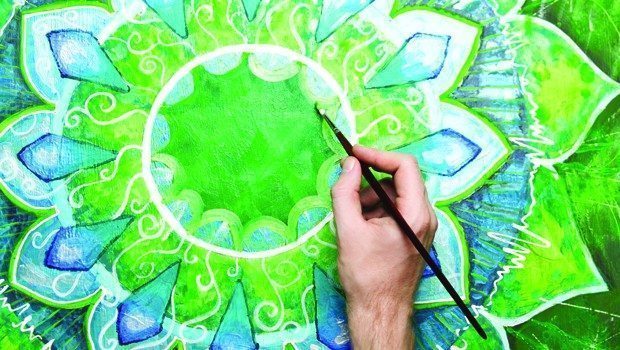Green Arts, Tips for Finding Safe Eco-Supplies
“Creative energy is contagious,” says Kim Harris, co-owner of Yucandu, a hands-on craft studio in Webster Groves, Missouri. As one client crafter commented, “Art is cheaper than therapy and a lot more fun.” It doubles the pleasure when we trust the nature of our supplies.
Arts and crafts stir the imagination, spur creativity and are relaxing. Yet, for some, allergies, chemical sensitivities and eco-consciousness can make choosing materials a challenge. Manufacturers are not required to list heavy metals, toxic preservatives or petroleum-based ingredients, even when they’re labeled “non-toxic”.
User- and environment-friendly alternatives may be difficult to locate, but are worth the effort. After working with paint, glue, chalk and modeling dough, children may lick their fingers and be reluctant to wash hands thoroughly. Retirees with newfound time for hobbies may also have weakened immune systems at risk to chemical exposure. Everyone benefits from minimizing exposure to toxins.
Papers
For greeting cards, scrapbooking or mixed media, paper provides background, texture, pattern and color. Tree-free paper uses agricultural residue or fibers from bananas, coffee and tobacco, and EcoPaper.com researchers anticipate similar future use of pineapples, oranges and palm hearts.
Labels can be misleading. White paper has been bleached. Processed chlorine-free (PCF) means no bleaching occurred during this incarnation of the paper. Totally chlorine-free (TCF) papers are as advertised. Paper is called recycled if it’s 100 percent postconsumer-recovered fiber—anything less is recycled content.
Glues
For most projects, purchased glues are more convenient, longer lasting and easier to use than homemade. White glue and white paste, called “library paste”, are best with porous items like wood, paper, plastic and cloth. It takes longer to dry and needs to be held in place, but there are no fumes.
“Jewelry is wearable art, so for mine, I primarily use water-based, non-toxic glues and sealers that simply wash off my hands,” advises Nancy Kanter, owner and designer of Sparkling Vine Design, in Thousand Oaks, California. Examples include Elmer’s Washable and Mod Podge.
Airplane glue, rubber cement, spray adhesive and epoxy all emit toxic fumes. Instant glue (cyanoacrylate) likewise bonds fast to fingers; toxic, foul-smelling acetate (used in nail polish remover) is needed for to remedy the situation.
Paints
Water-based tempera paint is easy to use; Chroma tempera removes some of the hazardous ingredients. “I use water-based, non-toxic acrylic paints and wine to paint recycled wine corks for my designs,” says Kanter. “This avoids harsh fumes and chemicals.”
Note that acrylic paint can contain ammonia or formaldehyde. Oil paint produces fumes and requires turpentine, a petroleum-based product, to clean brushes. Aerosol spray paint is easily inhaled unless protective equipment is used.
Markers and Crayons
“Give kids great supplies and they’ll make great art,” maintains Harris. “They’ll also be respectful of how much they use.”
Go for unscented, water-based markers, especially for younger children that are as apt to draw on themselves as on paper. Soy crayons are made from sustainable soybean oil, while retaining bright colors. Dustless chalk is preferred by some. Colored eco-pencils are another option.
If paint, glue, chalk or markers have a strong odor or the label says, “Use in a well-ventilated area,” it’s toxic.
Beware of conventional dry erase markers, which contain a neurotoxin; permanent markers emit fumes. Wax crayons are made with paraffin, a petroleum-based product.
Yarn and Other Fibers
For knit or crochet projects, choose recycled silk and cotton or bamboo, soy silk from tofu byproducts, or natural, sustainable corn silk. Sheep’s wool, organic cotton or alpaca fibers, raw or hand-dyed with natural colors, are environmentally friendly.
Rayon is recycled wood pulp treated with caustic soda, ammonia, acetone and sulfuric acid. Nylon, made from petroleum products, may have a harmful finish.
More Materials
Canvas is typically stretched on birch framing, a sustainable wood. Look for unbleached, organic cotton canvas without primer. Runoff from an organic cotton field doesn’t pollute waterways.
Experiment with homemade modeling clay. Many tutorials and photos are available online. Commercial modeling clay contains wheat flour, which can cause a reaction for the gluten-sensitive.
For papier-mâché projects, recycle newsprint and use white glue, thinned with water. Premade, packaged versions may contain asbestos fibers. Eco-beads with safe finishes vary from nuts and seeds to glass and stone. For grownups that like to create their own beads, realize that polymer clays contain vinyl/PVC.
In making artistic expression safe, being conscious of the materials used is primary.
Connect with the freelance writer via AveryMack@mindspring.com.




























